David W. Berner's Blog, page 3
January 23, 2018
On Winter Writing
Your intuition knows what to write, so get out of the way. —
Ray Bradbury.
Last night left a dusting of snow on this morning of dim light and colorless sky. The temperatures were in the 50s yesterday. Today, we'll get no better than 34 degrees. I had to turn on the heater inside the writer shed an hour early to be sure it would be tolerable to remain inside for a few hours of navigating my way around what I've been writing. Still, there's beauty in the harsh air and the bleakness of a late January day. It's the shades of gray, the hues of white and black, and just enough chill in the air to remind you that we have some time to go before the newness of a spring. This is what I might label as the time of anticipatory despair. I predict more winter gloom before the light of a new season.
 And this is exactly how I feel creatively.
And this is exactly how I feel creatively.
It's not unusual. It's the norm. Anyone who creates feels this. What am I doing? Why am I doing it? Is this any good? Is anything I've ever done any good? Will I write myself out of a cold season into a warm one? I've had a sliver of success with my writing. A few awards. Relatively good reviews. But it's not about the outside accolades; it's about the inside accolades.
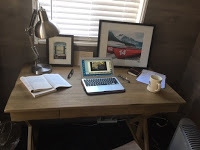
Don't worry. This is not going to be some navel-gazing piece about artistic self-doubt. How trite. Pathetic. Boring. Instead, this is about how this sort of gloom, this kind of mini despair, is useful. Even needed. To get to the spring, one must endure winter and all its cold and seclusion and all those shades of gray. Just below the snow that has settled on the barren branches are the yet unseen buds of seasonal blooms. So, the writer puts on his heaviest boots, his thickest coat, his densest wool cap and trudges forth because he knows that if he can hike his way through the weather, knowing there is something good on the other side, he will discover some kind of art. He's been here before. He's questioned it all before. But he knows seasons change. They always do. He knows he's doing what he can. He knows there's something down there below the surface, under the snow.
Three hours behind the walls of the writer shed produced 2,464 words today. Time and space will let me know if any of them are any good.
Last night left a dusting of snow on this morning of dim light and colorless sky. The temperatures were in the 50s yesterday. Today, we'll get no better than 34 degrees. I had to turn on the heater inside the writer shed an hour early to be sure it would be tolerable to remain inside for a few hours of navigating my way around what I've been writing. Still, there's beauty in the harsh air and the bleakness of a late January day. It's the shades of gray, the hues of white and black, and just enough chill in the air to remind you that we have some time to go before the newness of a spring. This is what I might label as the time of anticipatory despair. I predict more winter gloom before the light of a new season.
 And this is exactly how I feel creatively.
And this is exactly how I feel creatively.It's not unusual. It's the norm. Anyone who creates feels this. What am I doing? Why am I doing it? Is this any good? Is anything I've ever done any good? Will I write myself out of a cold season into a warm one? I've had a sliver of success with my writing. A few awards. Relatively good reviews. But it's not about the outside accolades; it's about the inside accolades.

Don't worry. This is not going to be some navel-gazing piece about artistic self-doubt. How trite. Pathetic. Boring. Instead, this is about how this sort of gloom, this kind of mini despair, is useful. Even needed. To get to the spring, one must endure winter and all its cold and seclusion and all those shades of gray. Just below the snow that has settled on the barren branches are the yet unseen buds of seasonal blooms. So, the writer puts on his heaviest boots, his thickest coat, his densest wool cap and trudges forth because he knows that if he can hike his way through the weather, knowing there is something good on the other side, he will discover some kind of art. He's been here before. He's questioned it all before. But he knows seasons change. They always do. He knows he's doing what he can. He knows there's something down there below the surface, under the snow.
Three hours behind the walls of the writer shed produced 2,464 words today. Time and space will let me know if any of them are any good.
Published on January 23, 2018 15:00
January 15, 2018
#dayofwriting
I can't stop myself from taking notes. While having morning coffee, I jot things down in the little notebook that I carry with me most days; I send myself cryptic comments in a text or email when all I have is the phone. I talk through my thoughts—out loud—when I'm driving the dog to PetSmart to give her a bath and write one-word-remembrances on an old business card I find in the car's cupholder. And then, at some point, usually early in the morning unless it is bitterly cold—temperatures below 20-degrees—I head to the writing shed and get to work. If not, then to a local coffee shop.
I'm calling this entire process, this never-ending work of writing. #dayofwriting.
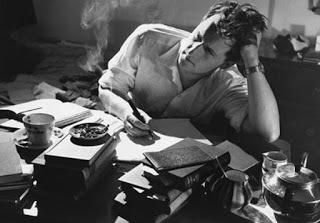 Every writer I know keeps notes, is always thinking of writing, is hearing dialogue at a grocery store checkout and stealing moments from it. A well-known Chicago writer recently revealed at a reading that she got the title of her collection of stories while in the shower. Or was it while washing her hair? Anyway, you get the idea. Writing is...all the time. It's #dayofwriting. In reality, it's #nightofwriting, too. Dreams come to us and we awaken, searching for our notebooks to write it all down.
Every writer I know keeps notes, is always thinking of writing, is hearing dialogue at a grocery store checkout and stealing moments from it. A well-known Chicago writer recently revealed at a reading that she got the title of her collection of stories while in the shower. Or was it while washing her hair? Anyway, you get the idea. Writing is...all the time. It's #dayofwriting. In reality, it's #nightofwriting, too. Dreams come to us and we awaken, searching for our notebooks to write it all down.
Writing is a 24-hour gig. Not that it's digging latrines or delicate brain surgery. Not that it requires the bravery of a soldier or policeman; not that it employs the smarts of an MIT mathematician. But our heads are always churning, thinking, developing, observing, sensing, shaping, massaging. This is not a complaint or the rant of a look-how-special-we-tortured-artists-are writer. No, it's only a clarification of the work.
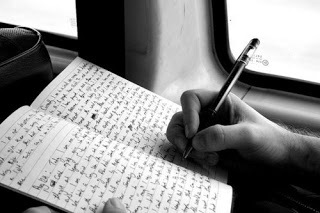 Let me explain.
Let me explain.
When I've conducted readings or workshops, I am almost always asked this question: When do you write?
I default to this answer: I'm a morning writer, mostly. I like early in the day. Can't write for more than a few hours at a time. I take a break and sometimes I get back at it later.
But that's only the actual writing, the physical putting fingers on computer keys and trying to type out something that makes sense. The real answer to "When do you write?" is this: Every single moment of every single day. It's all the notetaking, the research, the staring into the sky, the walks around the neighborhood, the meeting at the college where I work when I should be thinking about curriculum and I'm instead wondering what my character is supposed to say in that critical scene when his father dies. The real work is being done between tiny slivers of time when I am doing something else.
#dayofwriting
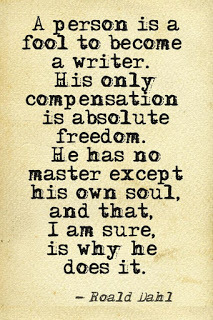 So, with this, I thought it would be fun, on a semi-regular basis, to post a video, a photo, a thought with the hashtag #dayofwriting, and document, for lack of a better word, the writing "process." Not always, but now and then, when I'm doing the work—the physical typing or just talking through something, daydreaming or hurriedly jotting down a nugget of information—I will share it at #dayofwriting on social media—Facebook, Instagram, or Twitter. I'm currently trying to flush out a manuscript, so it's a good time—or maybe a bad time—to embark on this little exercise.
So, with this, I thought it would be fun, on a semi-regular basis, to post a video, a photo, a thought with the hashtag #dayofwriting, and document, for lack of a better word, the writing "process." Not always, but now and then, when I'm doing the work—the physical typing or just talking through something, daydreaming or hurriedly jotting down a nugget of information—I will share it at #dayofwriting on social media—Facebook, Instagram, or Twitter. I'm currently trying to flush out a manuscript, so it's a good time—or maybe a bad time—to embark on this little exercise.
We'll see. Happy #dayofwriting.
FB: @DavidWBernerWrites
Twitter: @davidwberner
Instagram: DavidWBerner
I'm calling this entire process, this never-ending work of writing. #dayofwriting.
 Every writer I know keeps notes, is always thinking of writing, is hearing dialogue at a grocery store checkout and stealing moments from it. A well-known Chicago writer recently revealed at a reading that she got the title of her collection of stories while in the shower. Or was it while washing her hair? Anyway, you get the idea. Writing is...all the time. It's #dayofwriting. In reality, it's #nightofwriting, too. Dreams come to us and we awaken, searching for our notebooks to write it all down.
Every writer I know keeps notes, is always thinking of writing, is hearing dialogue at a grocery store checkout and stealing moments from it. A well-known Chicago writer recently revealed at a reading that she got the title of her collection of stories while in the shower. Or was it while washing her hair? Anyway, you get the idea. Writing is...all the time. It's #dayofwriting. In reality, it's #nightofwriting, too. Dreams come to us and we awaken, searching for our notebooks to write it all down. Writing is a 24-hour gig. Not that it's digging latrines or delicate brain surgery. Not that it requires the bravery of a soldier or policeman; not that it employs the smarts of an MIT mathematician. But our heads are always churning, thinking, developing, observing, sensing, shaping, massaging. This is not a complaint or the rant of a look-how-special-we-tortured-artists-are writer. No, it's only a clarification of the work.
 Let me explain.
Let me explain. When I've conducted readings or workshops, I am almost always asked this question: When do you write?
I default to this answer: I'm a morning writer, mostly. I like early in the day. Can't write for more than a few hours at a time. I take a break and sometimes I get back at it later.
But that's only the actual writing, the physical putting fingers on computer keys and trying to type out something that makes sense. The real answer to "When do you write?" is this: Every single moment of every single day. It's all the notetaking, the research, the staring into the sky, the walks around the neighborhood, the meeting at the college where I work when I should be thinking about curriculum and I'm instead wondering what my character is supposed to say in that critical scene when his father dies. The real work is being done between tiny slivers of time when I am doing something else.
#dayofwriting
 So, with this, I thought it would be fun, on a semi-regular basis, to post a video, a photo, a thought with the hashtag #dayofwriting, and document, for lack of a better word, the writing "process." Not always, but now and then, when I'm doing the work—the physical typing or just talking through something, daydreaming or hurriedly jotting down a nugget of information—I will share it at #dayofwriting on social media—Facebook, Instagram, or Twitter. I'm currently trying to flush out a manuscript, so it's a good time—or maybe a bad time—to embark on this little exercise.
So, with this, I thought it would be fun, on a semi-regular basis, to post a video, a photo, a thought with the hashtag #dayofwriting, and document, for lack of a better word, the writing "process." Not always, but now and then, when I'm doing the work—the physical typing or just talking through something, daydreaming or hurriedly jotting down a nugget of information—I will share it at #dayofwriting on social media—Facebook, Instagram, or Twitter. I'm currently trying to flush out a manuscript, so it's a good time—or maybe a bad time—to embark on this little exercise.We'll see. Happy #dayofwriting.
FB: @DavidWBernerWrites
Twitter: @davidwberner
Instagram: DavidWBerner
Published on January 15, 2018 06:54
January 2, 2018
Why I Write
I just read the final words of a wonderful book. It could have been the last sentences of many, many wonderful books that have sparked a new fire in me, but this time it was Patti Smith's Devotion, a short, soulful work on writing, the process of creation, and the call from something heavenly that turns the pen to write.
There is now for me, as Patti writes, a "call to action" and a certain "hubris to believe I can answer the call."
 Patti Smith, Courtesy Miami Book FairThis is what great works do. They ignite.
Patti Smith, Courtesy Miami Book FairThis is what great works do. They ignite.
When I was the writer-in-residence at the Jack Kerouac house in Orlando, working in the same room where he clanked out on his old manual typewriter the first draft of The Dharma Bums, I was overcome daily with the urge to rush into that bedroom space and inhale the DNA left behind, to ingest the mystical powers of the art of creation.
In the attic space at the Ernest Hemingway birthplace home in Oak Park, Illinois, where I was honored to take on the duties of the foundation's writer-in-residence, I again was compelled to write, to accept a great artist's energy, and try to convert it into my own.
 Kerouac's Orlando HomeSo why do I write? To be like them? To copy? To emulate? To steal the light of their brilliance? No, it is not this. Instead, I write to be bigger than myself, to create something fine and layered in meaning, to discover what the greats had, what they found so unforgiving, so necessary a task. I write because there is no other way to exist. I write to resolve some phrase that needs care, to adjust a sorry sack of words into enduring sentences, memorable prose or poetry that will hang just above the moon to shine a soft light on what gazes below it, who wishes on a star. I write to discover, to illuminate, to wander and to wonder. I write not to mimic the greats but to become who I am through them. They are necessary, they are inspirations, they are godlike, but they are only images, reflections, monuments to what I strive to do every single day—write.
Kerouac's Orlando HomeSo why do I write? To be like them? To copy? To emulate? To steal the light of their brilliance? No, it is not this. Instead, I write to be bigger than myself, to create something fine and layered in meaning, to discover what the greats had, what they found so unforgiving, so necessary a task. I write because there is no other way to exist. I write to resolve some phrase that needs care, to adjust a sorry sack of words into enduring sentences, memorable prose or poetry that will hang just above the moon to shine a soft light on what gazes below it, who wishes on a star. I write to discover, to illuminate, to wander and to wonder. I write not to mimic the greats but to become who I am through them. They are necessary, they are inspirations, they are godlike, but they are only images, reflections, monuments to what I strive to do every single day—write.
 Dylan Thomas' Writing Shed in Wales
Dylan Thomas' Writing Shed in Wales
In my writing shed, my modest 8X10 studio on the property where I live, I keep an original watercolor of Dylan Thomas' boathouse. On the wall, I will soon hang a sketch of Albert Camus by artist Nick Young. And I'm planning to print a photo of the Kerouac home in Florida where I lived for that glorious summer and tack it to the planked wall.
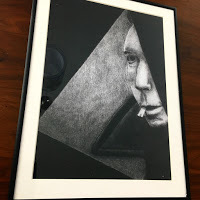 L'Algerien
by Nick Young
L'Algerien
by Nick Young
Each is a reminder to create something worthy of sharing, to write as one must in order to do far more than, as Patti Smith wrote, "simply live."
Why do you write? Why and how does it call you—that muse, that mysterious whispering spirit?
There is now for me, as Patti writes, a "call to action" and a certain "hubris to believe I can answer the call."
 Patti Smith, Courtesy Miami Book FairThis is what great works do. They ignite.
Patti Smith, Courtesy Miami Book FairThis is what great works do. They ignite.When I was the writer-in-residence at the Jack Kerouac house in Orlando, working in the same room where he clanked out on his old manual typewriter the first draft of The Dharma Bums, I was overcome daily with the urge to rush into that bedroom space and inhale the DNA left behind, to ingest the mystical powers of the art of creation.
In the attic space at the Ernest Hemingway birthplace home in Oak Park, Illinois, where I was honored to take on the duties of the foundation's writer-in-residence, I again was compelled to write, to accept a great artist's energy, and try to convert it into my own.
 Kerouac's Orlando HomeSo why do I write? To be like them? To copy? To emulate? To steal the light of their brilliance? No, it is not this. Instead, I write to be bigger than myself, to create something fine and layered in meaning, to discover what the greats had, what they found so unforgiving, so necessary a task. I write because there is no other way to exist. I write to resolve some phrase that needs care, to adjust a sorry sack of words into enduring sentences, memorable prose or poetry that will hang just above the moon to shine a soft light on what gazes below it, who wishes on a star. I write to discover, to illuminate, to wander and to wonder. I write not to mimic the greats but to become who I am through them. They are necessary, they are inspirations, they are godlike, but they are only images, reflections, monuments to what I strive to do every single day—write.
Kerouac's Orlando HomeSo why do I write? To be like them? To copy? To emulate? To steal the light of their brilliance? No, it is not this. Instead, I write to be bigger than myself, to create something fine and layered in meaning, to discover what the greats had, what they found so unforgiving, so necessary a task. I write because there is no other way to exist. I write to resolve some phrase that needs care, to adjust a sorry sack of words into enduring sentences, memorable prose or poetry that will hang just above the moon to shine a soft light on what gazes below it, who wishes on a star. I write to discover, to illuminate, to wander and to wonder. I write not to mimic the greats but to become who I am through them. They are necessary, they are inspirations, they are godlike, but they are only images, reflections, monuments to what I strive to do every single day—write.
 Dylan Thomas' Writing Shed in Wales
Dylan Thomas' Writing Shed in Wales In my writing shed, my modest 8X10 studio on the property where I live, I keep an original watercolor of Dylan Thomas' boathouse. On the wall, I will soon hang a sketch of Albert Camus by artist Nick Young. And I'm planning to print a photo of the Kerouac home in Florida where I lived for that glorious summer and tack it to the planked wall.
 L'Algerien
by Nick Young
L'Algerien
by Nick YoungEach is a reminder to create something worthy of sharing, to write as one must in order to do far more than, as Patti Smith wrote, "simply live."
Why do you write? Why and how does it call you—that muse, that mysterious whispering spirit?
Published on January 02, 2018 18:12
December 28, 2017
Commit to Writing in the New Year
Here's my New Year's resolution...write until the well is dry.
I am convinced we need more writers in 2018; more fearless, more brave, more courageous writers. Not that we don't have them now. We do. But more is better. More is necessary. Humans are meant to tell stories, to shine lights on our lives, our dreams and fears, and shared realities. But to do this, it takes more than simple desire or nebulous inspiration. Writing—fiction, nonfiction, personal essays, memoir—is essentially a hard-won discipline.
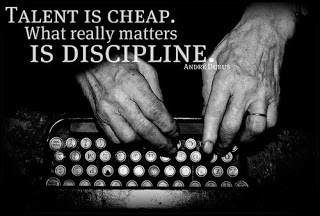 I am fortunate to conduct workshops of all kinds from time to time, and much of what I hear from writers and would-be writers is this: I can't find the time. How do you find the time to write?
I am fortunate to conduct workshops of all kinds from time to time, and much of what I hear from writers and would-be writers is this: I can't find the time. How do you find the time to write?
Here's the answer: There is no time to write. You have to make time. And in 2018, I am kicking all of us in the collective posterior, including myself, to...just...do...it. I'm pretty disciplined with my writing but just like you, I falter. There certainly was a time when I would say exactly what many of you say—I don't have the time. Now, writing is a part of my existence. I make time and refuse to wait for "inspiration." If you wait for some higher power, you may never write. For those trying to get to this point, I have a suggestion: In 2018 take part in what I call the Take Ten writing project. It's pretty simple. And even if you already have a disciplined routine, this project might help to renew your commitment.
Here's how it works in three easy steps:
1. Get a notebook. Something you use daily to dedicate to your writing. This can be a file on a computer or a nice leather journal or even a simple spiral notebook.
2. Write every single day. I know you've heard this before, but the Take Ten approach is a bit different. This time we want you to focus mainly, at least at the beginning, on simply creating a routine. You want writing to be like brushing your teeth, habitual. Find ten minutes. That's it. Morning, lunch, before bed. Find a spot that yours. On the train, on the couch, at the kitchen table.
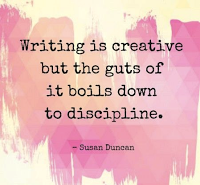 3. Lastly, write for those ten minutes and only those ten. Time it on your phone, your watch. Write anything. If you think you can or want to write longer, DON'T. Just write for ten minutes. Then, after ten days or so, write as long or as short as you like. But, and here's the key, from here on out keep writing at that time of day and at that same place. After ten days, the routine is likely to have become sealed somehow. If you set the routine in cement, the writing will come.
3. Lastly, write for those ten minutes and only those ten. Time it on your phone, your watch. Write anything. If you think you can or want to write longer, DON'T. Just write for ten minutes. Then, after ten days or so, write as long or as short as you like. But, and here's the key, from here on out keep writing at that time of day and at that same place. After ten days, the routine is likely to have become sealed somehow. If you set the routine in cement, the writing will come.
Routine is what you are looking for. It's the bugaboo of the discipline like it is for anything worthwhile and Take Ten helps you to set that routine.
The approach is not unique, but it is simple. And the less complicated, the better. You can do this.
I am convinced we need more writers in 2018; more fearless, more brave, more courageous writers. Not that we don't have them now. We do. But more is better. More is necessary. Humans are meant to tell stories, to shine lights on our lives, our dreams and fears, and shared realities. But to do this, it takes more than simple desire or nebulous inspiration. Writing—fiction, nonfiction, personal essays, memoir—is essentially a hard-won discipline.
 I am fortunate to conduct workshops of all kinds from time to time, and much of what I hear from writers and would-be writers is this: I can't find the time. How do you find the time to write?
I am fortunate to conduct workshops of all kinds from time to time, and much of what I hear from writers and would-be writers is this: I can't find the time. How do you find the time to write?Here's the answer: There is no time to write. You have to make time. And in 2018, I am kicking all of us in the collective posterior, including myself, to...just...do...it. I'm pretty disciplined with my writing but just like you, I falter. There certainly was a time when I would say exactly what many of you say—I don't have the time. Now, writing is a part of my existence. I make time and refuse to wait for "inspiration." If you wait for some higher power, you may never write. For those trying to get to this point, I have a suggestion: In 2018 take part in what I call the Take Ten writing project. It's pretty simple. And even if you already have a disciplined routine, this project might help to renew your commitment.
Here's how it works in three easy steps:
1. Get a notebook. Something you use daily to dedicate to your writing. This can be a file on a computer or a nice leather journal or even a simple spiral notebook.
2. Write every single day. I know you've heard this before, but the Take Ten approach is a bit different. This time we want you to focus mainly, at least at the beginning, on simply creating a routine. You want writing to be like brushing your teeth, habitual. Find ten minutes. That's it. Morning, lunch, before bed. Find a spot that yours. On the train, on the couch, at the kitchen table.
 3. Lastly, write for those ten minutes and only those ten. Time it on your phone, your watch. Write anything. If you think you can or want to write longer, DON'T. Just write for ten minutes. Then, after ten days or so, write as long or as short as you like. But, and here's the key, from here on out keep writing at that time of day and at that same place. After ten days, the routine is likely to have become sealed somehow. If you set the routine in cement, the writing will come.
3. Lastly, write for those ten minutes and only those ten. Time it on your phone, your watch. Write anything. If you think you can or want to write longer, DON'T. Just write for ten minutes. Then, after ten days or so, write as long or as short as you like. But, and here's the key, from here on out keep writing at that time of day and at that same place. After ten days, the routine is likely to have become sealed somehow. If you set the routine in cement, the writing will come. Routine is what you are looking for. It's the bugaboo of the discipline like it is for anything worthwhile and Take Ten helps you to set that routine.
The approach is not unique, but it is simple. And the less complicated, the better. You can do this.
Published on December 28, 2017 04:46
December 19, 2017
Surrounding the Writer with Great Things
Many of you know I have a writing shed. It's an 8x10 studio in my backyard of my home outside Chicago. Nothing fancy, but it's my singular space. I built the interior myself. It's heated. And inside, I have surrounded myself with wonderful things. Not a lot, but special items that either inspire me, motivate, or simply make me feel creative.
In your artistic space—whether it be where you write, sketch, paint, sculpt, sing, post in your daily journal entries, or mediatate—are you surrounded by beauty, love, comfort, your muse? Without sounding too pretentious, is that space "holy?" Not necessarily a place associated with a divine power, although it can be, but rather a sacred space of pilgrimage? When you enter this place, you should melt into it. There should be transformation. And sometimes the "things" we allow inside that space are what can help do that for us.
Here is what is in my space.
My shed has many books, but not all of them, only the ones that truly inspire and stimulate my own work.
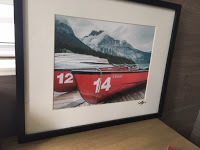
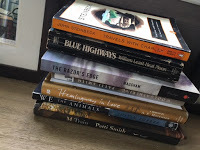 Art from loved ones gives me comfort. The photography is my son Casey's work. The bowl is my son Graham's. The tree painting is Jen's, my stepdaughter. And there's the pen Graham made. I use it to enter notes in a journal. There are remembrances. The hat is from the trip to Cuba with my boys; a baseball I caught in the stands at old Comiskey Park along the first base side; a photo of myself with a number of writers honored at the Chicago Library Foundation's Carl Sandburg Literary Awards. And an old typewriter just like the one in Hemingway's home in Key West. I found it in an antique shop decades ago.
Art from loved ones gives me comfort. The photography is my son Casey's work. The bowl is my son Graham's. The tree painting is Jen's, my stepdaughter. And there's the pen Graham made. I use it to enter notes in a journal. There are remembrances. The hat is from the trip to Cuba with my boys; a baseball I caught in the stands at old Comiskey Park along the first base side; a photo of myself with a number of writers honored at the Chicago Library Foundation's Carl Sandburg Literary Awards. And an old typewriter just like the one in Hemingway's home in Key West. I found it in an antique shop decades ago.
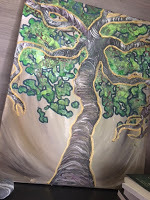
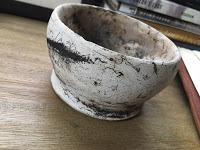 On my desk, a watercolor of Dylan Thomas' writing shed above a boathouse in Wales, a gift from Leslie, my wife, that I will forever cherish.
On my desk, a watercolor of Dylan Thomas' writing shed above a boathouse in Wales, a gift from Leslie, my wife, that I will forever cherish.
Silly things, too, like a Jack Kerouac bobblehead. I spent three months in 2009 as the writer-in-residence, living at Kerouac's Florida home. And against the wall, one of my two acoustic guitars. It's the old Yamaha I bought when I was 16 with the money I'd saved from delivering the Pittsburgh Press newspaper to my neighbors. The guitar still sounds great.
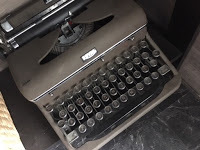 Now and then I add items, but not many. Recently, I purchased an illustration, a print by my friend and colleague Nick Young. It's a portrait of Albert Camus. Camus' book The Stranger is on my top twenty list of all time. The framed print is on its way by UPS and there's a spot on the shed's wall waiting for it to arrive.
Now and then I add items, but not many. Recently, I purchased an illustration, a print by my friend and colleague Nick Young. It's a portrait of Albert Camus. Camus' book The Stranger is on my top twenty list of all time. The framed print is on its way by UPS and there's a spot on the shed's wall waiting for it to arrive.
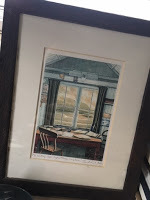

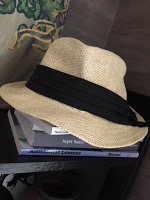

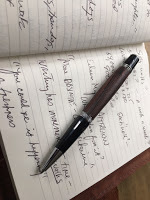
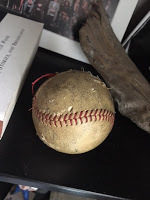
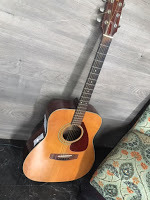
Fill your space with what invigorates, soothes, or stimulates you, and rid it of anything that takes you out of that experience. Build a place for solitude and daydreaming, where you can get out of your own head. Eliminate the distractions and embrace the creative.
Henry David Thoreau wrote, “The world is but a canvas to the imagination.” Take his advice and paint your space with all that triggers the beautiful, the daring, the expressive.
In your artistic space—whether it be where you write, sketch, paint, sculpt, sing, post in your daily journal entries, or mediatate—are you surrounded by beauty, love, comfort, your muse? Without sounding too pretentious, is that space "holy?" Not necessarily a place associated with a divine power, although it can be, but rather a sacred space of pilgrimage? When you enter this place, you should melt into it. There should be transformation. And sometimes the "things" we allow inside that space are what can help do that for us.
Here is what is in my space.
My shed has many books, but not all of them, only the ones that truly inspire and stimulate my own work.

 Art from loved ones gives me comfort. The photography is my son Casey's work. The bowl is my son Graham's. The tree painting is Jen's, my stepdaughter. And there's the pen Graham made. I use it to enter notes in a journal. There are remembrances. The hat is from the trip to Cuba with my boys; a baseball I caught in the stands at old Comiskey Park along the first base side; a photo of myself with a number of writers honored at the Chicago Library Foundation's Carl Sandburg Literary Awards. And an old typewriter just like the one in Hemingway's home in Key West. I found it in an antique shop decades ago.
Art from loved ones gives me comfort. The photography is my son Casey's work. The bowl is my son Graham's. The tree painting is Jen's, my stepdaughter. And there's the pen Graham made. I use it to enter notes in a journal. There are remembrances. The hat is from the trip to Cuba with my boys; a baseball I caught in the stands at old Comiskey Park along the first base side; a photo of myself with a number of writers honored at the Chicago Library Foundation's Carl Sandburg Literary Awards. And an old typewriter just like the one in Hemingway's home in Key West. I found it in an antique shop decades ago. 
 On my desk, a watercolor of Dylan Thomas' writing shed above a boathouse in Wales, a gift from Leslie, my wife, that I will forever cherish.
On my desk, a watercolor of Dylan Thomas' writing shed above a boathouse in Wales, a gift from Leslie, my wife, that I will forever cherish.Silly things, too, like a Jack Kerouac bobblehead. I spent three months in 2009 as the writer-in-residence, living at Kerouac's Florida home. And against the wall, one of my two acoustic guitars. It's the old Yamaha I bought when I was 16 with the money I'd saved from delivering the Pittsburgh Press newspaper to my neighbors. The guitar still sounds great.
 Now and then I add items, but not many. Recently, I purchased an illustration, a print by my friend and colleague Nick Young. It's a portrait of Albert Camus. Camus' book The Stranger is on my top twenty list of all time. The framed print is on its way by UPS and there's a spot on the shed's wall waiting for it to arrive.
Now and then I add items, but not many. Recently, I purchased an illustration, a print by my friend and colleague Nick Young. It's a portrait of Albert Camus. Camus' book The Stranger is on my top twenty list of all time. The framed print is on its way by UPS and there's a spot on the shed's wall waiting for it to arrive.






Fill your space with what invigorates, soothes, or stimulates you, and rid it of anything that takes you out of that experience. Build a place for solitude and daydreaming, where you can get out of your own head. Eliminate the distractions and embrace the creative.
Henry David Thoreau wrote, “The world is but a canvas to the imagination.” Take his advice and paint your space with all that triggers the beautiful, the daring, the expressive.
Published on December 19, 2017 15:52
December 15, 2017
How a Detox Cleanse Helped My Writing
My wife and I recently went on a cleanse. It consisted of two weeks of greens, very few carbs, no red meat, a mind-spinning number of salads, plenty of fish, no dairy, tons of water, and no alcohol or caffeine (which we cheated on a bit). We tolerated broccoli for breakfast and endured absolutely no chocolate. But we made it.
For me, the first few days induced a carb-crash. I was irritable, tired to the point of being weak, and even dizzy. I missed toast with my coffee. I missed my occasional scone. I missed my sandwich with thick bread for lunch. But I got over it. After 4-5 days in, it was a breeze. Energy was back and even renewed. When I struggled, Leslie shined and was incredibly supportive, making nearly all the meals and preparing my food for away-from-home lunches. Now, a week after the cleanse, we are accepting and embracing a new way of eating. It wasn't as if we were daily burger eaters, fast-food junkies, or Twinkies addicts. But this new commitment to eating leaner and simpler foods, and focusing far more on whole foods rather than processed, is a distinctly new discipline for eating, especially for me.
 So what's this have to do with writing?
So what's this have to do with writing?
As I was chewing on another Brussels sprout, (which I love, by the way) I also considered how the choice of what we put in our bodies is much the same as the many choices we make when writing. We all know that certain words are better than others, a major factor in good prose. "Processed" words—that is to say words that are overused, pretentious, or pompous, words with too many junky "carbs"—are bad. Look for lean, simple words, "whole" words that are distinctive and clean. Don't over-garnish your meals or your writing. Too much sugar makes for an over-sentimentalized story. Too much "salt" leads to water retention and bloated prose. As writers, when we overdo "red meat," it can lead to "clogged arteries" and the story (our blood) struggles to flow with any ease through our vessels. Our hearts—and the hearts of our stories—suffer.
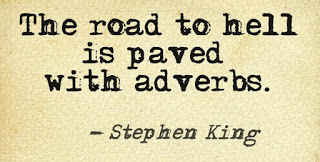 Go on a writing cleanse. Rid your writing of excess, waste and empty energy. You'll not only feel better, your writing will be better, too.
Go on a writing cleanse. Rid your writing of excess, waste and empty energy. You'll not only feel better, your writing will be better, too.
For me, the first few days induced a carb-crash. I was irritable, tired to the point of being weak, and even dizzy. I missed toast with my coffee. I missed my occasional scone. I missed my sandwich with thick bread for lunch. But I got over it. After 4-5 days in, it was a breeze. Energy was back and even renewed. When I struggled, Leslie shined and was incredibly supportive, making nearly all the meals and preparing my food for away-from-home lunches. Now, a week after the cleanse, we are accepting and embracing a new way of eating. It wasn't as if we were daily burger eaters, fast-food junkies, or Twinkies addicts. But this new commitment to eating leaner and simpler foods, and focusing far more on whole foods rather than processed, is a distinctly new discipline for eating, especially for me.
 So what's this have to do with writing?
So what's this have to do with writing?As I was chewing on another Brussels sprout, (which I love, by the way) I also considered how the choice of what we put in our bodies is much the same as the many choices we make when writing. We all know that certain words are better than others, a major factor in good prose. "Processed" words—that is to say words that are overused, pretentious, or pompous, words with too many junky "carbs"—are bad. Look for lean, simple words, "whole" words that are distinctive and clean. Don't over-garnish your meals or your writing. Too much sugar makes for an over-sentimentalized story. Too much "salt" leads to water retention and bloated prose. As writers, when we overdo "red meat," it can lead to "clogged arteries" and the story (our blood) struggles to flow with any ease through our vessels. Our hearts—and the hearts of our stories—suffer.
 Go on a writing cleanse. Rid your writing of excess, waste and empty energy. You'll not only feel better, your writing will be better, too.
Go on a writing cleanse. Rid your writing of excess, waste and empty energy. You'll not only feel better, your writing will be better, too.
Published on December 15, 2017 15:49
December 12, 2017
Evidence of Flossing: Review
I am not a student of poetry, meaning I am not an academic of verse. But I am a lover of poetry and those who write it well. William Butler Yeats, Dylan Thomas, Mary Oliver, and my modern day favorite, Billy Collins. Poetry is personal; it is visceral. If I feel something when I read it, then it has done its job. If it makes me cry, smile, or laugh out loud, then it has cracked the space between poetry's far-too-often perceived pretentiousness and given me art, art for the heart.
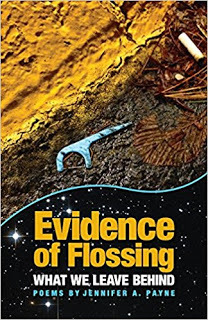 Much of what one finds in Evidence of Flossing: What We Leave Behind by Jennifer A. Payne, does just that. The collection is a mixture of photo art, journalistic photography, and verse that runs from social commentary to wide-eyed and microscopic observations. The poems are mostly about connection, how all of us and everything in the universe, even flossers, those weirdly shaped do-dads we use to clean our teeth, are part of the human condition. One of the themes of the book is linked to photographs of found flossers—in parking lots, on grassy knolls, next to a cigarette butt and to vegetation in a nature preserve. In mostly succinct verse, Payne wonders about the universe, the threads that connect and bind, and how even the most obscure items—like flossers—blend into our being, and at the end of the day, belong here just as all of us. I don't like to compare the works of authors to others, but I could not help feel and read the similarities in the themes to those of Patti Smith's M Train. Smith's wonderful book is not poetry, but it is about the ephemeral and the everlasting, the threads between modern life, people, art, nature, and the spirit. Payne takes on the same themes and includes, as Smith does, the photography of what one might call "the instant." Photography that is of the moment, unpretentious, real, and utterly of the world.
Much of what one finds in Evidence of Flossing: What We Leave Behind by Jennifer A. Payne, does just that. The collection is a mixture of photo art, journalistic photography, and verse that runs from social commentary to wide-eyed and microscopic observations. The poems are mostly about connection, how all of us and everything in the universe, even flossers, those weirdly shaped do-dads we use to clean our teeth, are part of the human condition. One of the themes of the book is linked to photographs of found flossers—in parking lots, on grassy knolls, next to a cigarette butt and to vegetation in a nature preserve. In mostly succinct verse, Payne wonders about the universe, the threads that connect and bind, and how even the most obscure items—like flossers—blend into our being, and at the end of the day, belong here just as all of us. I don't like to compare the works of authors to others, but I could not help feel and read the similarities in the themes to those of Patti Smith's M Train. Smith's wonderful book is not poetry, but it is about the ephemeral and the everlasting, the threads between modern life, people, art, nature, and the spirit. Payne takes on the same themes and includes, as Smith does, the photography of what one might call "the instant." Photography that is of the moment, unpretentious, real, and utterly of the world.
And the verse? Payne has a keen eye and a warm, tender heart. This is evident in poems like "The Times They Are a Changin'" and "Grocery Store: November 2016." Payne reveals an almost spiritual connection to the lives of others and proves how observation can unfold someone's story. In "Time Peace," she wonders about our unbearable links to the clock, how the man-made construct is capable of throwing us off the personal timepiece that ticks inside our souls. Payne takes on nature in several poems, but particularly in "Carpe Diem," where she touches on the fleeting nature of the natural world and how inattention to wonder—like the flight of a butterfly—can only diminish our well-being.
Other poems like "First" and "Sustenance" are less impactful, falling a little flat for their subjects, but none-the-less important to the overall tenor of this otherwise thoughtful collection, a beautiful undertaking that is more than just a book of 'poems, but an artful, multi-layered statement about our very humanness and the universe.
The French poet and novelist, Victor Hugo, wrote, "The reduction of the universe to the compass of a single being, and the extension of a single being until it reaches God—that is love." Jennifer A. Payne expands on those words with an unflinching account of our unshakeable relationship to the modern world around us, God, nature, and ourselves.
Evidence of Flossing: What We Leave Behind, poems by Jennifer A. Payne.
 Much of what one finds in Evidence of Flossing: What We Leave Behind by Jennifer A. Payne, does just that. The collection is a mixture of photo art, journalistic photography, and verse that runs from social commentary to wide-eyed and microscopic observations. The poems are mostly about connection, how all of us and everything in the universe, even flossers, those weirdly shaped do-dads we use to clean our teeth, are part of the human condition. One of the themes of the book is linked to photographs of found flossers—in parking lots, on grassy knolls, next to a cigarette butt and to vegetation in a nature preserve. In mostly succinct verse, Payne wonders about the universe, the threads that connect and bind, and how even the most obscure items—like flossers—blend into our being, and at the end of the day, belong here just as all of us. I don't like to compare the works of authors to others, but I could not help feel and read the similarities in the themes to those of Patti Smith's M Train. Smith's wonderful book is not poetry, but it is about the ephemeral and the everlasting, the threads between modern life, people, art, nature, and the spirit. Payne takes on the same themes and includes, as Smith does, the photography of what one might call "the instant." Photography that is of the moment, unpretentious, real, and utterly of the world.
Much of what one finds in Evidence of Flossing: What We Leave Behind by Jennifer A. Payne, does just that. The collection is a mixture of photo art, journalistic photography, and verse that runs from social commentary to wide-eyed and microscopic observations. The poems are mostly about connection, how all of us and everything in the universe, even flossers, those weirdly shaped do-dads we use to clean our teeth, are part of the human condition. One of the themes of the book is linked to photographs of found flossers—in parking lots, on grassy knolls, next to a cigarette butt and to vegetation in a nature preserve. In mostly succinct verse, Payne wonders about the universe, the threads that connect and bind, and how even the most obscure items—like flossers—blend into our being, and at the end of the day, belong here just as all of us. I don't like to compare the works of authors to others, but I could not help feel and read the similarities in the themes to those of Patti Smith's M Train. Smith's wonderful book is not poetry, but it is about the ephemeral and the everlasting, the threads between modern life, people, art, nature, and the spirit. Payne takes on the same themes and includes, as Smith does, the photography of what one might call "the instant." Photography that is of the moment, unpretentious, real, and utterly of the world. And the verse? Payne has a keen eye and a warm, tender heart. This is evident in poems like "The Times They Are a Changin'" and "Grocery Store: November 2016." Payne reveals an almost spiritual connection to the lives of others and proves how observation can unfold someone's story. In "Time Peace," she wonders about our unbearable links to the clock, how the man-made construct is capable of throwing us off the personal timepiece that ticks inside our souls. Payne takes on nature in several poems, but particularly in "Carpe Diem," where she touches on the fleeting nature of the natural world and how inattention to wonder—like the flight of a butterfly—can only diminish our well-being.
Other poems like "First" and "Sustenance" are less impactful, falling a little flat for their subjects, but none-the-less important to the overall tenor of this otherwise thoughtful collection, a beautiful undertaking that is more than just a book of 'poems, but an artful, multi-layered statement about our very humanness and the universe.
The French poet and novelist, Victor Hugo, wrote, "The reduction of the universe to the compass of a single being, and the extension of a single being until it reaches God—that is love." Jennifer A. Payne expands on those words with an unflinching account of our unshakeable relationship to the modern world around us, God, nature, and ourselves.
Evidence of Flossing: What We Leave Behind, poems by Jennifer A. Payne.
Published on December 12, 2017 05:21
November 21, 2017
Five Tips for Reading Your Work to a Live Audience
I like doing readings. It's great to be in front of people in a tavern, a bookstore, a lit event at a library, reading your words to a crowd. Even if that crowd is five people. Yes, I've had that happen. Just the other night, in fact. Sometimes reading events just don't work out the way you hope. Still, you knuckle down and do it. You read with the same enthusiasm and with the same love of the words as you would for a hundred people.
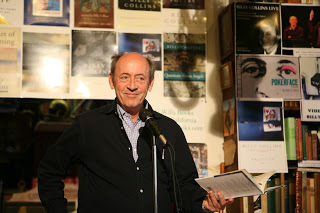 Billy Collins
Billy Collins
There is a trick to reading aloud for an audience. Some authors are not very good at it. I attended a reading for a well-known bestselling author a few years ago (I won't say who—It was NOT Billy Collins) who was an awful reader of his own work. Reading takes a bit of acting, if you will. Now, I'm not suggesting I am the world's greatest live reader. I'm not. But I think I do know how to approach it and mostly my readings have gone pretty well.
Here are a five tips for reading your work to a live audience.
1. Choose something that is self-contained—a scene, a chapter—something that has a reasonable beginning, middle, and end. A part of a book that needs too much explanation before reading or while reading doesn't work. It slows down your pace and energy.
2. Read slower than you think you should. Reading aloud takes patience. Don't rush it.
3. Vary your pace. When the action is cranking, read faster. When that lovely moment in the story is emerging, slow down.
4. Keep up the volume. Depending on where you read, be sure people can hear you. If there's a microphone, use it if the room is big. If it's a small place, I suggest NOT using the microphone. It destroys the intimacy.
5. Look at your audience. Try your best to lift your head and look around the room. Smile. Laugh when appropriate. Be present.
Keep these in mind when you do a radio interview, too. Obviously the microphone is necessary and you may not have a "live" audience in studio. But they are out there. That's for certain.
I recently broadcast a recorded reading for a radio station, WNIJ outside Chicago. And although I think I could have been a bit livelier with this read, I think it went pretty well. Take a look and listen to the first chapter of my memoir, October Song.
Oh, one final thought about reading to an audience. Have fun. It should be fun. And if you have fun, your audience will, too.
 Billy Collins
Billy CollinsThere is a trick to reading aloud for an audience. Some authors are not very good at it. I attended a reading for a well-known bestselling author a few years ago (I won't say who—It was NOT Billy Collins) who was an awful reader of his own work. Reading takes a bit of acting, if you will. Now, I'm not suggesting I am the world's greatest live reader. I'm not. But I think I do know how to approach it and mostly my readings have gone pretty well.
Here are a five tips for reading your work to a live audience.
1. Choose something that is self-contained—a scene, a chapter—something that has a reasonable beginning, middle, and end. A part of a book that needs too much explanation before reading or while reading doesn't work. It slows down your pace and energy.
2. Read slower than you think you should. Reading aloud takes patience. Don't rush it.
3. Vary your pace. When the action is cranking, read faster. When that lovely moment in the story is emerging, slow down.
4. Keep up the volume. Depending on where you read, be sure people can hear you. If there's a microphone, use it if the room is big. If it's a small place, I suggest NOT using the microphone. It destroys the intimacy.
5. Look at your audience. Try your best to lift your head and look around the room. Smile. Laugh when appropriate. Be present.
Keep these in mind when you do a radio interview, too. Obviously the microphone is necessary and you may not have a "live" audience in studio. But they are out there. That's for certain.
I recently broadcast a recorded reading for a radio station, WNIJ outside Chicago. And although I think I could have been a bit livelier with this read, I think it went pretty well. Take a look and listen to the first chapter of my memoir, October Song.
Oh, one final thought about reading to an audience. Have fun. It should be fun. And if you have fun, your audience will, too.
Published on November 21, 2017 12:15
November 8, 2017
NaNoWriMo: How Not to Stop Writing
So, you’re working through NaNoWriMo. How’s it going? No, really, how’s it truly going? Be honest. Stuck? Is the flow being knocked off balance because you are incessantly editing? You’re worried everything you’ve been writing is garbage so you go back and check it, “fix” it, and edit, edit, edit.

If you’ve read my blog before you know I have a love-hate relationship with NaNo. I get the idea; I even applaud it. But really, do we need a special month? Why can’t we just get to it anytime, anywhere? Write, people. Just write. And learning to HOLD OFF ON THE EDITING—in the month of November or any month—is key to shredding your anxiety.
If you're so concerned with your work that you are continually going over it, page-by-page, sentence-by-sentence, while you are writing, then you are wasting valuable time and effort. Stop self-editing, pulling yourself back into the prose you wrote the day before, tweaking and twisting the story...before you create it. Create first.
Here are five tips to help keep you writing and not editing.
1. Write while listening to music. Make a playlistof songs that fit the theme of your work and time it out roughly to the amount of time you have dedicated to write. Play it loud, through speakers or in your ear buds. Let music be your guide. Write with its rhythm, think of it as a workout, and don’t stop typing until the last chord.
Some music to consider: Miles Davis, Kind of Blue; The Decemberists, What a Terrible World, What a Beautiful World; Bob Dylan, Blood on the Tracks.
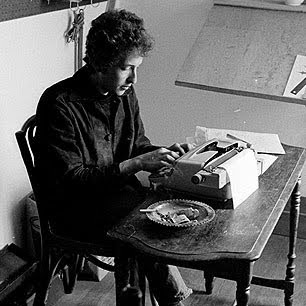
2. So you don’t stop to look something up or do research, write in a placeholder. This was a suggestion I’ve seen in several books and web articles, including the BREVITY’S Nonfiction Blog, and I’ve been doing it in my work for years. Instead of wrecking the flow of your writing to search for information about which way the Chicago River runs, just type: LOOK UP CHICAGO RIVER INFO. This reminds you to do it later and and not while you’re writing.
3. Consider a hard deadline and a stop sign. Don’t write until you have depleted the well. Leave a little. Write for an hour, or two. Set a timer. (Use that music!) But when the time is up, stop. Even in mid-sentence. This helps when you come back the next time. You can get going right away.
4. Turn off your Internet connection. It takes away the temptation to check your email, Twitter, or roam the web.
5. This is the time to only look forward. Do not look back. You are writing something meaningful, interesting, compelling, beautiful. But to get there, remind yourself that you have to let the flowers grow first before you prune. No pruning now. Let the garden grow, weeds and all. Then, and only then, when it is in full bloom, start the work of trimming, clipping, shaping, and fertilizing. Weeds may choke real flowers if you let them invade the garden, but the weeds in writing will only help you to see the beautiful blooms.
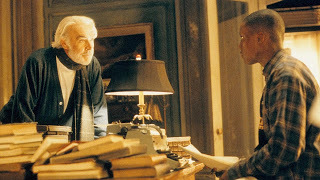 There’s a wonderful scene in the movie
Finding Forrester
when Sean Connery’s character—a recluse writer who befriends a young city boy who dreams of being a writer—teaches the young man a lesson about the craft of writing. He sits him down and demands that he get on with it. You have work to do. Go write.
There’s a wonderful scene in the movie
Finding Forrester
when Sean Connery’s character—a recluse writer who befriends a young city boy who dreams of being a writer—teaches the young man a lesson about the craft of writing. He sits him down and demands that he get on with it. You have work to do. Go write.

If you’ve read my blog before you know I have a love-hate relationship with NaNo. I get the idea; I even applaud it. But really, do we need a special month? Why can’t we just get to it anytime, anywhere? Write, people. Just write. And learning to HOLD OFF ON THE EDITING—in the month of November or any month—is key to shredding your anxiety.
If you're so concerned with your work that you are continually going over it, page-by-page, sentence-by-sentence, while you are writing, then you are wasting valuable time and effort. Stop self-editing, pulling yourself back into the prose you wrote the day before, tweaking and twisting the story...before you create it. Create first.
Here are five tips to help keep you writing and not editing.
1. Write while listening to music. Make a playlistof songs that fit the theme of your work and time it out roughly to the amount of time you have dedicated to write. Play it loud, through speakers or in your ear buds. Let music be your guide. Write with its rhythm, think of it as a workout, and don’t stop typing until the last chord.
Some music to consider: Miles Davis, Kind of Blue; The Decemberists, What a Terrible World, What a Beautiful World; Bob Dylan, Blood on the Tracks.

2. So you don’t stop to look something up or do research, write in a placeholder. This was a suggestion I’ve seen in several books and web articles, including the BREVITY’S Nonfiction Blog, and I’ve been doing it in my work for years. Instead of wrecking the flow of your writing to search for information about which way the Chicago River runs, just type: LOOK UP CHICAGO RIVER INFO. This reminds you to do it later and and not while you’re writing.
3. Consider a hard deadline and a stop sign. Don’t write until you have depleted the well. Leave a little. Write for an hour, or two. Set a timer. (Use that music!) But when the time is up, stop. Even in mid-sentence. This helps when you come back the next time. You can get going right away.
4. Turn off your Internet connection. It takes away the temptation to check your email, Twitter, or roam the web.
5. This is the time to only look forward. Do not look back. You are writing something meaningful, interesting, compelling, beautiful. But to get there, remind yourself that you have to let the flowers grow first before you prune. No pruning now. Let the garden grow, weeds and all. Then, and only then, when it is in full bloom, start the work of trimming, clipping, shaping, and fertilizing. Weeds may choke real flowers if you let them invade the garden, but the weeds in writing will only help you to see the beautiful blooms.
 There’s a wonderful scene in the movie
Finding Forrester
when Sean Connery’s character—a recluse writer who befriends a young city boy who dreams of being a writer—teaches the young man a lesson about the craft of writing. He sits him down and demands that he get on with it. You have work to do. Go write.
There’s a wonderful scene in the movie
Finding Forrester
when Sean Connery’s character—a recluse writer who befriends a young city boy who dreams of being a writer—teaches the young man a lesson about the craft of writing. He sits him down and demands that he get on with it. You have work to do. Go write.
Published on November 08, 2017 07:01
October 28, 2017
EVERY Month Should be NaNoWriMo
A couple of years ago, I produced a piece for radio on NaNoWriMo. The writing initiative was fairly new back then, so fewer people were taking part. But still, the idea was unique and inspiring for many aspiring writers. It was a chance to buckle down and be held accountable, especially when you publicly announced you were taking part, or joined a
NaNoWriMo
group, which is what my radio story was about. I like
NaNoWriMo
. It can be a motivator, a coach. But I think it's run its course and it's time writers in all stages see the difference between a gimmicky way to get writers writing and a lesson on how to be disciplined about your craft.
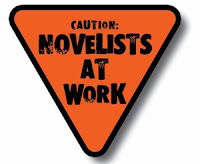
It's time NaNoWriMo morphed into NaNoWriYEAR .
You want to write? Make it part of your life. Get to it like you do your yoga class. Do it regularly and don't let anyone or anything knock you off your schedule. Five minutes a day? Do it. One hour every other day? Do it. Write on the commuter train? Do it. Write before the kids get up. Write after they go to bed. Find a place and a time and stick to it. And most of all, don't wait until November. Why can't June be the month? February? And better yet, every single day.
Hear NaNoWriMo radio story at my web site. left column, on the home page.

It's time NaNoWriMo morphed into NaNoWriYEAR .
You want to write? Make it part of your life. Get to it like you do your yoga class. Do it regularly and don't let anyone or anything knock you off your schedule. Five minutes a day? Do it. One hour every other day? Do it. Write on the commuter train? Do it. Write before the kids get up. Write after they go to bed. Find a place and a time and stick to it. And most of all, don't wait until November. Why can't June be the month? February? And better yet, every single day.
Hear NaNoWriMo radio story at my web site. left column, on the home page.
Published on October 28, 2017 04:44



